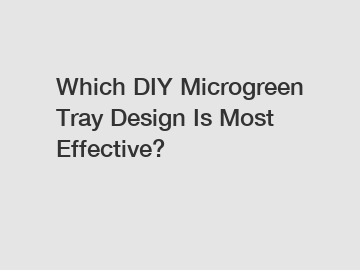Feb. 12, 2024
Home & Garden
MARSHINE Product Page
Which DIY Microgreen Tray Design Is Most Effective?
As the popularity of microgreens continues to grow, many gardening enthusiasts are opting to grow their own at home. Microgreens not only add a burst of flavor and color to dishes but are also packed with nutrients. One of the key considerations for successfully growing microgreens is the choice of tray design. With several DIY tray designs available, it can be challenging to determine which one is the most effective. In this article, we will explore various microgreen tray designs and discuss their pros and cons to help you make an informed decision.

1. The Standard Plastic Tray:
The most common and simple design for microgreen trays is the standard plastic tray. These trays are readily available, affordable, and durable. They often come with drainage holes at the bottom to prevent waterlogging, a significant concern when growing microgreens. The flat surface of the tray allows for easy spreading of seeds and subsequent harvest. However, one drawback of these trays is their shallow depth, which limits the growth potential of some types of microgreens that require more soil depth.
2. Seedling Trays with Inserts:
Seedling trays with inserts offer a clever solution to the limitations of standard trays. These trays feature separate compartments or cells, which allow for better organization of different types of microgreens. Each compartment can be used for a different variety, making it easier to track growth and harvest. Moreover, the depth of the cells is generally more suitable for microgreens with longer roots. However, the individual compartments might restrict air circulation, potentially leading to mold or mildew issues if not properly managed.
3. Vertical Stackable Trays:
Vertical stackable trays are gaining popularity among microgreen enthusiasts for their space efficiency. These trays come with multiple levels stacked on top of each other, allowing for increased production in a compact setup. This design is particularly useful for those with limited gardening space. Additionally, the vertical orientation sometimes helps to promote more even growth by providing better access to light. However, it is essential to note that watering multiple levels can be a bit tricky and may require careful attention to prevent any overflow or uneven distribution.
4. Recycled Materials Tray:
For those interested in sustainable gardening practices, using recycled materials as microgreen trays can be an excellent option. Old food containers or shallow wooden boxes can serve as cost-effective and eco-friendly alternatives. These DIY trays can be easily customized to fit available space or specific growing needs. However, it is crucial to ensure that the chosen material is safe for growing edible plants and that proper drainage is provided.
In conclusion, the choice of microgreen tray design depends on various factors, including space availability, seed variety, and personal preferences. The standard plastic tray is a reliable and common choice due to its simplicity and affordability. If you require more depth or wish to grow different varieties separately, seedling trays with inserts are a suitable option. Vertical stackable trays offer optimal space utilization and can be beneficial for those with limited gardening space. Lastly, using recycled materials as trays is a sustainable choice but requires careful consideration regarding safety and proper drainage. Ultimately, by considering these different design options and their respective pros and cons, you can determine which DIY microgreen tray design is most effective for your specific needs.
If you are looking for more details, kindly visit our website.
For more information, please visit plastic plant trays wholesale.
Previous: Affordable Mesh Fabric: Budget-friendly Solutions for All
Next: What are the best whitening strips that don t damage your teeth?
If you are interested in sending in a Guest Blogger Submission,welcome to write for us!
All Comments ( 0 )